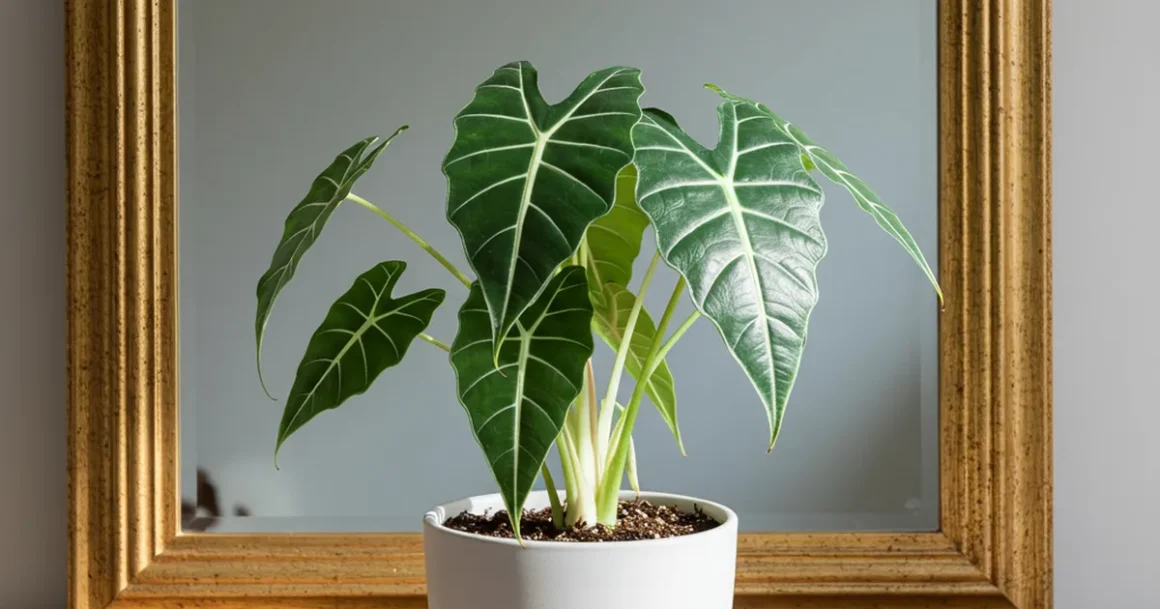Introduction:
Alocasia frydek is an impressive plant with dark green velvety leaves adorned with striking white veins. While it is commonly cultivated as a houseplant, it can also thrive outdoors in tropical regions. Like most Alocasia species, ensuring the well-being of alocasia frydek can be challenging, but the beauty of its foliage makes the effort rewarding.
In addition to warm temperatures, bright indirect light, and a well-draining acidic potting mix, these tropical plants require high humidity and regular moisture to avoid issues in dry conditions or extended periods of drought.
| Common Name | Alocasia frydek, green velvet alocasia, elephant’s ear |
| Botanical Name | Alocasia micholitziana ‘Frydek’ |
| Family | Araceae |
| Plant Type | Herbaceous, perennial |
| Mature Size | 2-3 ft. tall, 2-3 ft. wide |
| Sun Exposure | Partial |
| Soil Type | Moist, well-drained |
| Soil pH | Acidic |
| Bloom Time | Spring, summer |
| Flower Color | Green |
| Hardiness Zones | 9-11 (USDA) |
| Native Area | Asia |
| Toxicity | Toxic to humans and pets |
Trimming

If you come across yellowed, brown, or damaged leaves, you should eliminate them using a sharp, sterilized cutting tool such as a pair of pruning shears.
If your alocasia frydek is in good health and thriving, you might observe a green spadix appearing from the plant’s center. This is a flower. While flowering is uncommon for alocasia frydek grown indoors, it can happen with mature plants.
As the flowers of alocasia frydek are not as noteworthy as its distinctive foliage, many gardeners opt to trim the flowers by cutting them off, enabling the plant to focus its energy on producing more leaves. You can choose to do this, but it is not mandatory.
Transplanting Alocasia Frydek

Alocasia frydek prefers to be slightly root-bound and should only be transplanted once every two to three years. The ideal time for transplanting is in the spring or early summer, when the plant is no longer inactive.
Select a new pot that is one to two sizes larger, and try to replace most of the old potting soil without harming the plant’s roots.
Wintering

When cultivated indoors, it is typical for Alocasia plants to shed all their leaves and enter a dormant state during the winter season. Do not worry if your plant appears lifeless as the temperature drops outside. As long as the bulb remains healthy and alive, the plant will sprout again in the spring.
Keep in mind that fertilization and watering should be minimal while the plant is dormant. Water only when the top half of the soil has dried out. Once a new leaf emerges in the spring, resume regular watering.
Common Pests
Alocasia frydek can be affected by various common pests such as fungus gnats, spider mites, mealybugs, scale, and thrips. It is important to regularly check your plant for any signs of pests to detect possible infestations at an early stage.
In case you discover any pests, promptly treat your plant with neem oil or an indoor insecticidal soap, and keep it separated from your other indoor plants to avoid spreading.
Common Issues with Alocasia Frydek
Like many Alocasias, keeping Alocasia Frydek happy indoors can be challenging. It can thrive under the right conditions, but always watch out for the following problems.
Wilting Leaves
Alocasias are sensitive to sudden changes in their environment and may show wilting leaves when their growing conditions shift. Changes in light, temperature, humidity, and watering can all lead to droopy outer leaves that may eventually wither.
If your plant is still receiving adequate light, water, humidity, and warmth, it should recover once it adjusts to the new conditions.
Leaf Loss
Sometimes, if there is a sudden environmental change for Alocasia Frydek, it might start shedding some or all of its leaves. This is often seen in fall and winter when temperatures decrease and daylight hours shorten.
As the plant goes dormant, it sheds its leaves and regrows them in early spring. Although this can be alarming, as long as the bulb is healthy, your Frydek will bounce back.
If you observe leaf loss during spring or summer, assess its growing conditions to identify the possible cause. Has there been a sudden alteration in its environment? Is it receiving enough light, water, and humidity? Identifying the issue can prevent further leaf loss.
Yellowing Leaves
Yellow leaves are often a sign of overwatering or underwatering. Make sure the plant’s soil remains evenly moist. Keep Alocasia Frydek in a pot with drainage holes so excess water can drain away from the roots.
Other Plants You May Like
-
Guide on Growing and Caring for Alocasia Black Velvet
-
Guide on Growing and Caring for Alocasia Stingray
-
Guide on Growing and Caring for Alocasia Maharani
-
Guide on Growing and Caring for Alocasia Pink Dragon
-
Guide on Growing and Caring for Alocasia Silver Dragon
1 of 5

